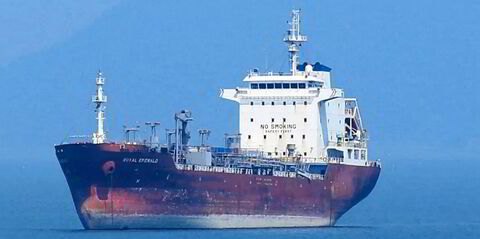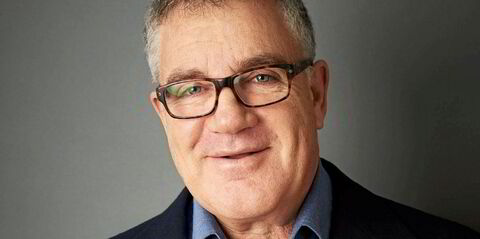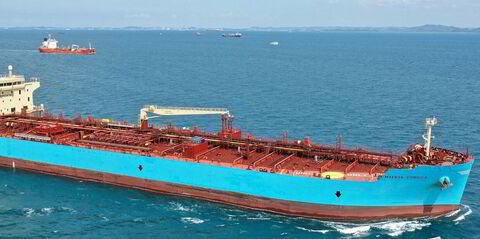AP Moller-Maersk has added another world first in its efforts to be the container shipping sector’s decarbonisation leader.
Its goal of reaching net zero greenhouse gas emissions by 2040 has been certified by the Science Based Targets initiative, making it the first shipping company to do so, as TradeWinds has reported.
But how do environmental advocacy groups view its decarbonisation pathway, and do they want Maersk to up its game further?
The Green Seas podcast explored this question with leaders of Ship It Zero, an initiative led by Stand.earth and Pacific Environment to persuade major retail brands to procure shipping with zero-emission fuels.
And in a second segment, TradeWinds technology editor Craig Eason spoke to Alisha Fredriksson, chief executive of Seabound, which has a unique approach to pursuing carbon capture on ships.
Listen on the player above or on Google Podcasts, Apple Podcasts, Stitcher, Pandora, Spotify or SoundCloud.
This is Green Seas, the podcast by TradeWinds about the environment and the business of the ocean. I’m Eric Priante Martin. And today, we’re going to talk about a shipping giant’s newly validated climate targets and one company’s unique approach to capturing carbon from vessels.
Danish Shipping giant AP Moller Maersk made headlines in recent months by putting the first methanol-fuelled container ship on the water, heralding a new push into powering its vessels — at least the newly built ones — with green fuels.
But as it released its annual report recently, that wasn’t the main event.
This is chief executive Vincent Clerc briefing analysts about the company’s annual results and guidance for the rest of the current year that was gloomier than investors hoped.
“We go into 2024 with a significant supply-side challenge in shipping. We spoke about it in November ’23, and that remains unchanged. The Red Sea disruption is absorbing some of the overcapacity temporarily. However, the structural imbalance will catch up during 2024 and exacerbate over time, irrespective of whether the situation in the Red Sea endures or resolves itself.”
What wasn’t mentioned in that earnings call was the latest decarbonisation achievement by Maersk: It has become the first shipping company to have its decarbonisation targets validated by the Science-Based Targets initiative, or SBTi.
Environmental groups have applauded Maersk’s announcement that its greenhouse gas targets, including its goal to hit net zero by 2040, have earned what is considered a “gold standard” for climate targets.
But that doesn’t mean the NGOs have given Maersk an A grade.
To figure out the nuances of how environmental campaigners see Maersk’s climate goals, I spoke to leaders of Ship It Zero, an effort led by Pacific Environment and Stand.earth to persuade major brands that are container shipping companies’ customers to move their cargoes on green fuels.
But first, here’s how the SBTi works.
The non-profit initiative validates companies’ climate targets against the Paris Agreement’s aim to halt global temperature rises at 1.5 degrees Celsius above pre-industrial levels. And it requires more ambition than meeting the goals of the International Maritime Organization, which is aiming for net zero by around 2050.
For members of Ship It Zero, the thumbs-up from SBTi is meaningful.
This is Jim Ace, a senior campaigner at Stand.earth: “This is a first for a carrier. A breakthrough. I mean, this is great news. So let’s be very clear about Maersk’s leadership. And we saw this in our report card from last year: that Maersk was very clearly a leader head and shoulders above its competition.”
Maersk got a B grade on that report card, by the way, better than any other container shipping company.
Grace Healy is interim senior director for Pacific Environment’s climate campaign.
“I think it’s really important that we see these corporations, these large companies who have so much power, really take bold action, even ahead of what we’re seeing come out of regulatory bodies. So I think, just from that perspective, it’s really important that corporations are taking steps, are acting as leaders and are not waiting to be regulated into taking these steps.”
Maersk is gearing up to have a fleet of 18 methanol-powered container ships by the end of 2025, out of a total of 25 that it has ordered. And it has made major strides in signing up for green methanol — the more sustainable version of the fuel — to power its vessels.
But the Ship It Zero team wants Maersk to do more.
Ace said it can do that by putting its ships on a path to net zero by 2030, rather than 2040, and as Maersk focuses on building new ships, Pacific Environment pointed to its large fleet of ships that the company already operates.
Healy said: “That’s really what we’re looking for: not only looking to the newbuilds, which we know Maersk is also leading on, but really setting some specific benchmarks around how they’re going to retrofit the many ships that they already have on the water.”
Maersk is working on a pilot project to retrofit one of its vessels to run on methanol, and it’s planning for that to be a model for more.
For Healy, while green methanol is a great transitional fuel, it’s not the only thing shipping companies should be looking at, and it’s not the end game.
“Our position is: electrify everything that can be electrified and then from there start to look towards hydrogen-based fuels with a strong preference for ultimately green hydrogen in a fuel cell because that is truly zero-emission.”
The push for more ambitious action is not just about climate change.
Healy said: “Again, we’re so thrilled to see Maersk taking this huge step and really be a leader but, Eric, as you know, if shipping were a country it would be the world’s sixth-largest polluter. This is such a large but often overlooked issue. And really those shipping pollution impacts — they’re not out at sea … they are, but they’re also very much in the port communities where those ships are unloading goods. And so often, particularly in the US, those port communities are often low-income and communities of colour. We really think that corporations owe it to those communities to take bold action beyond just looking at climate impacts but really looking at the public health impacts and not wasting a single moment before they really look to implement zero-emission pathways.”
But let’s not forget that Maersk is far ahead of other liner operators.
Ace said: “We’ll be watching Maersk but also its competitors. Maersk set the bar and really now it’s up to its competitors to up their game. And we’re eager to engage with those companies to figure out work with them on what’s next. Because, as you know, this is a big year. The next couple of years are very big years for the climate [and] big years in these communities. So we’re eager to see a lot of progress in the coming year.”
Now, we’re going to turn to another topic in the effort to tackle shipping’s greenhouse gas footprint. TradeWinds technology editor Craig Eason takes it from here.
The British government has, over the last four years, been funding a range of decarbonisation projects, projects which also support British cleantech start-ups with solutions for the maritime sector.
It is the Clean Maritime Demonstration Competition, or CMDC.
And amongst the projects examining wind propulsion, electrification and future fuel supply and use is one which is one looking at capturing the carbon dioxide that gets emitted by a ship when its engines are running.
The company is London-based Seabound, launched only two years ago by co-founders Alisha Fredriksson and Roujia Wen.
Fredriksson is no stranger to the push to decarbonise shipping: she was previously helping her father develop a company in Sweden, called Liquid Wind, which is focused on making green methanol bunkers for shipping.
Fredriksson said: “Seabound was started about two years ago now to focus on developing onboard carbon capture equipment for the shipping industry and we have already done a series of trials on land with our technology to iteratively de-risk it. So we did lab-based prototyping and testing, and then kind of larger-scale workshop testing, and then once we had seen promising results with our latest prototype here in London, we wanted to test it out in the real world, to see how it would fare with a real engine. So we started speaking to many owners, Lomar included, and came across, at around the same time, the Clean Maritime Demonstration Competition from the UK government. So we jointly applied for CMDC, round three, with Lomar, and together we secured funding. It is actually for a two-stage pilot project. We’ve completed the first stage now, which was initially a relatively small-scale carbon capture system, given the size of the ship that we installed it on. And then the next stage will actually be the first commercial-scale version of our system, so we will still have ongoing funding from CMDC to do the next round.”
Seabound is not the only start-up or project looking at marinising the concept of carbon capture so it can work on board a ship.
But while most of the other projects and companies — I know of about 10 — focus on using an amine liquid to spray through ship exhaust fumes to catch the CO2, Seabound is different.
It is based on the chemical fact that calcium oxide, also called caustic soda, changes into limestone, chemically known as calcium carbonate, when in contact with carbon dioxide.
That first stage of the CMDC project was undertaken on a Lomar Shipping vessel, the Sounion Trader. It’s a Liberian-flagged boxship built in 2003. It was due for a regular dry-docking early last year. And Lomar’s technology investment group Lomarlabs, which is backing the project, Alisha and the Seabound team headed off to the yard in Turkey with their prototype and prepared to install and test their idea in the real world.
Fredriksson said: “Our goal since starting Seabound has been to develop and demonstrate our technology as quickly as possible, and so that’s actually why we put what was a prototype onto a container ship. You can almost think of it as using the vessel as a ship-shaped lab. So it was really about testing it in the real world, but not necessarily about designing the first commercial-scale version and putting it out there. We want to sort of like de-risk it iteratively. We spent several weeks actually based at a shipyard, to be able to conduct the installation together with the shipyard workers as well. So it’s a pretty intense amount of working in that environment every day. I think one of the things we took away from it was just underscoring the importance of modularity. I think it’s something you hear people talk about a lot in the industry. It’s something that’s already been on our minds. But given the challenges of building and installing new equipment out of yard, I think it was further emphasised how important that’ll be for our next design. So that was one of the key pieces that we took away.”
After the testing, the prototype was taken off the containership and shipped back to the warehouse in London as Seabound prepare for the second stage.
So while Alisha told me the trials went well, I wanted to ask her about the use of the calcium oxide pebbles which the carbon dioxide binds onto, hence the company name, I suppose. Now clearly the system will only be able to remove as much CO2 as there are unreacted pebbles available.
Once they are used, the remaining engine exhaust has to be emitted as it is today into the atmosphere until new pebbles are loaded.
Fredriksson said: “In terms of the storage capacity, I think it’s the same challenge with any type of storage tank onboard a vessel, right. So you’ve got a tank for a particular size, whether it be pure CO2, or CO2 in the form of calcium carbonate. So it’s just really about mapping out how large of a storage tank or how many storage tanks do you need on board a vessel, given the route. In terms of the types of routes, it’s certainly easier for us to start with fixed predictable routes, because we know where to set up that supply chain, essentially, because Seabound takes care of the calcium oxide supply in the calcium carbonate collection. However, given that we can just off offload it and sell it as calcium carbonate, we actually are a bit more flexible than pure CO2 solutions, which is where we think even tramp voyages could be possible in the future.”
Alisha also told me that the pebbles can either be used in other industries, as limestone is a sellable commodity, but it can also be treated, extracting the CO2 for either use or sequestering, and the now reformed caustic soda pebbles sent back to the ship for use.
But as a two-year-old company with only a prototype model with which it has done tests so far, Seabound has a long way to go to reach commercialisation and market maturity. Even the regulations are not yet fully in place amongst international regulators, but there is no doubt there’s interest, especially given the environmental regulation road map about shipping.
But will Seabound be able to bring its idea to maturity?
Fredriksson said: “It is not something that keeps me up at night. Because I think our systems are definitely not as expensive as some of the challenges that other start-ups might face where you’re building a battery factory, or you are standing up an electro fuel plant or … you know, we’re building systems that are relatively small, relatively inexpensive, compared to really large-scale projects like that. And so, you know, as we think about raising our next round of funding, which will be our Series A, we can budget for the initial few systems in our upcoming fundraise budget, so that we have enough buffer to play with from a cash flow perspective. But we don’t need to be budgeting for building factories. So I think that’s where this is a relatively cash-light business as far as hardware businesses go from. Yeah, and we’re very fortunate for that.”
Read more about sustainability in shipping at Tradewindsnews.com/sustainability
Music for this episode is by Crystal Squad on Tunetank.


